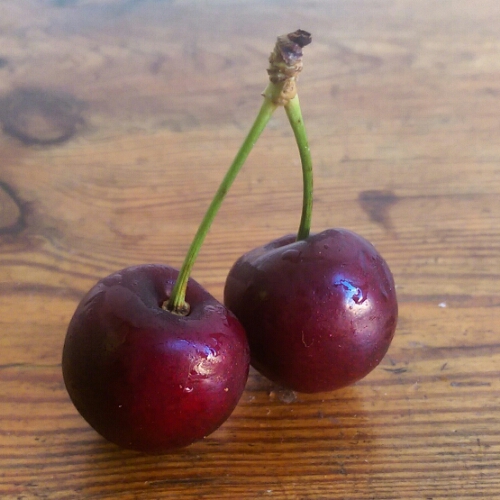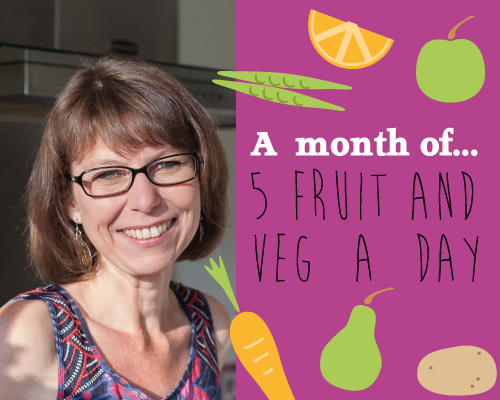Today I’m interviewing Karen from The Sensitive Kitchen about her food journey, her business based off her experience and some hints and tips to getting more fruit and veg into your food.
 Hello Karen, thank you for talking to me today. First question – what is The Sensitive Foodie Kitchen and what do you do?
Hello Karen, thank you for talking to me today. First question – what is The Sensitive Foodie Kitchen and what do you do?
The Sensitive Foodie Kitchen is a business I set up at the beginning of last year, primarily to promote the benefits of eating a plant based whole food diet through talks and taster sessions. I do cooking demos to teach people how to make great dairy and meat based alternatives and carry out one to one sessions with people who want to make changes to the way they eat, often due to health and/or food allergy problems, but need help in doing so. I realised that the best way to illustrate to people that healthy food can be really gorgeous tasty food was to feed them; this started off in my talks and taster sessions, and I now do monthly supper clubs offering a four course seasonal menu to treat the tastebuds and body. I am also developing a 6 week support course, a physical attendance one and an on-line one, to provide more on-going support to people who find making changes a bit hard and need more contact and group support.
How did The Sensitive Foodie start?
As all good things do – through personal pain and frustration! I had always suffered from headaches and a ‘dodgy stomach’ throughout my life, some times worse than others. In 2008, after a particularly stressful period in my life, I started to suffer from almost continual headaches and/or migraines. I consulted my GP who told me I was fine and just keep taking the painkillers (the NICE guidelines have since changed thank goodness!). As a nurse, I didn’t want to do that due to potential side effects, so decided to work out what was triggering them. In the past, I was always on one diet or another, and had been on Carol Vorderman’s detox diet – during this time I felt much better so realised it was something to do with food, and eventually got a food allergy test done. This told me I was sensitive to dairy and yeast. So basically, all the things I liked to eat were making me sick – cheese, cakes, bread, wine….. So I started my journey of discovery into how to feel better.
Initially, I just cut out dairy and yeast products which I found hard but felt better – I soon learnt that the consquences of eating a delicous creamy pudding were really not worth those few minutes of indulgence, and started to look at making my own alternatives. Luckily I enjoy cooking and experimenting so decided to make it fun rather than a chore. Then we moved to India with my husbands job; as I was not working, I decided to study nutritional medicine to understand more about the connection between food and health. I also started my blog – The Sensitive Foodie – initially writing about eating dairy-free.
Then I met Dr Nandita Shah who heads up an organisation in India called SHARAN. She teaches various courses about using food as medicine and promotes a plant based whole food diet. After attending various courses and cooking demos, I decided to cut out all animal based products – this was when I finally started to really experience the benefits of eating well. On our return to the UK, I wanted to use everything I’d learnt and share it with others, so set up The Sensitive Foodie Kitchen, connecting it with the blog.
Since having a very fruit and veg filled diet, what differences have you found in your life?
Minimal headaches (it’s very difficult to avoid yeast products so I still get some if eating out), more energy, better skin, less irritable (I used to get hunger related moods swings), fewer coughs, colds etc and, apart from improving the headaches, probably the best – weight loss. Having spent my life yoyo dieting, I no longer have to worry about my weight. And as someone who really enjoys eating, I can eat loads and feel good about it rather than guilty. It’s liberating!
 In one of your blogs you state that only 30% of people hit that 5 a day target – have you found this to be true?
In one of your blogs you state that only 30% of people hit that 5 a day target – have you found this to be true?
Yes! And now the 5 a day target no longer includes fruit juice, some people will struggle to get one! So many people are reliant on processed products, they don’t really think of fruit and vegetables as food, or believe they are getting their fruit for example from a strawberry yoghurt, which has probably never seen a strawberry. Many people have issues related to eating fruit and vegetables too which is hard to deal with, often related to family or school dinners. Lots of people tell my they have bought a nutribullet, so I’m hoping they use them for healthy smoothies rather than let them gather dust at the back of a cupboard!
Do you have any hints or tips to getting 5 fruit and veg a day in a diet?
If you have a blender, make a smoothie. Use some berries, a banana and a couple of handfuls of spinach and you’re well on your way. You can take it to work to drink during the day, or fill up there and then.
Eat soup – there’s so many different vegetable soup recipes out there that are easy to make and delicious to eat. Have some at lunch time and it will fill you up. Check out my blog for ideas.
Snack on fruit rather than biscuits
Add it to cake – carrot, courgette, beetroot are all great in cake and help reduce the amount of fat you need to use.
Have a salad before your main meal – it can be as simple or as complicated as you like, but don’t make it boring!
Add more veg to stews, stir fries or curries. Too much salt or spice can ruin a dish. Too much veg won’t!
I’m someone who has always struggled to eat fruit and veg – do you have any hints and tips that you would give to fellow super tasters or fussy eaters?
Some of the above work well, particularly smoothies, soups, stews and cake! Soups are great if texture is an issue, as they can be pureed to a completely smooth texture. Homemade soups are always better than shop bought as you can alter the flavour and texture to how you want it. Using vegetables in different ways to ‘normal’ can also help. For example, cauliflower, a key contender for most disliked vegetable, changes it’s flavour when roasted and can be made into a soup or sauce that tastes almost cheezy. Roasting caramelises vegetables and often makes them more palatable for those who struggle with flavours.
What is your favourite food?
I have a bit of a thing for aspargus and green beans, and get rediculously excited when they’re in season! But deep down I still have a very sweet tooth, so raw banoffee pie is heaven on a spoon!
Thank you to Karen for sharing her expertise today – it really is interesting to hear that only 30% of people on average are getting their 5 a day! If you want to find out more about Karen and get more tips for eating healthy at her website at www.thesensitivefoodiekitchen.com. You can also get recipe ideas at her blog at www.foodiesensitive.blogspot.com or check out her Facebook at www.facebook.com/TheSensitiveFoodie for updates, events and demos.
Are you one of the 30% hitting 5 a day? Do you use a nutribullet? Have you found out any interesting tips? Will be trying out any recipes or lessons from Karen? I would love to hear from you so leave a comment below.



0 Comments